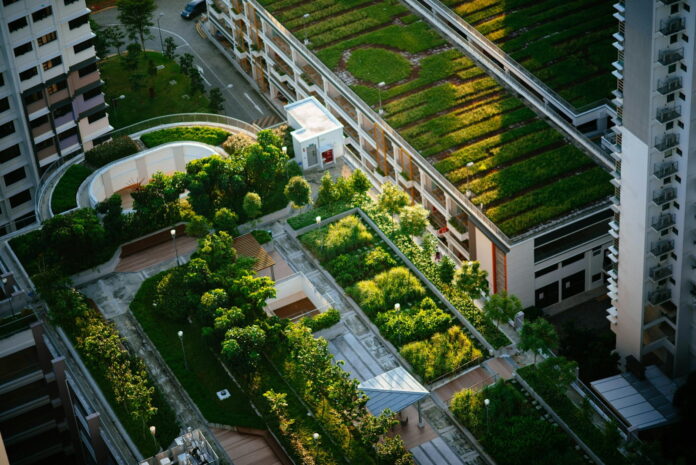As cities continue to expand, the concrete jungle grows denser, giving rise to a phenomenon known as the Urban Heat Island (UHI) effect, where urban regions experience higher temperatures than their rural surroundings. This temperature disparity is attributed to the absorption and retention of heat by buildings, roads, and other infrastructure. However, amidst this growing concern, green roofs have emerged as a beacon of hope, offering a sustainable solution to mitigate the UHI effect while simultaneously enhancing environmental health.
Green Roofs: Urban Heat Island Combatants
Green roofs, also known as living roofs, are an innovative approach to urban design that incorporate vegetation on rooftops. They serve as a natural insulator for buildings, reducing the need for artificial cooling and, consequently, the overall urban temperature. By replacing traditional roofing materials with plants, green roofs absorb less heat and reflect more solar radiation back into the atmosphere, directly combating the UHI effect. This cooling phenomenon is further enhanced by the process of evapotranspiration, where plants release water vapor into the air, contributing to lower ambient temperatures.
The implementation of green roofs across urban landscapes has shown a measurable decrease in the UHI effect. Studies have demonstrated that areas with a high density of green roofs can experience a significant reduction in peak temperatures, especially during summer months. This not only alleviates the stress on power grids due to lower air conditioning demands but also reduces the occurrence of heat-related illnesses. The strategic placement of green roofs in urban hotspots has the potential to create cooler microclimates, making cities more livable and resilient to climate change.
Transitioning to green roofs is not without its challenges, including the initial installation costs and structural requirements. However, the long-term benefits outweigh these hurdles, as green roofs contribute to energy savings and extend the lifespan of roofing materials. Cities around the world are beginning to recognize these advantages and are incorporating green roof policies to encourage their adoption. By doing so, they are investing in a future where urban centers can remain vibrant without compromising on environmental quality.
The Ecological Impact of Rooftop Greenery
The ecological benefits of green roofs extend far beyond temperature regulation. They provide much-needed habitats for a variety of wildlife, particularly in urban areas where natural spaces are scarce. By fostering biodiversity, green roofs can serve as stepping stones for pollinators and birds, facilitating their movement across urban landscapes. This not only helps in the conservation of local fauna but also promotes a balance in the urban ecosystem.
Moreover, green roofs play a crucial role in managing stormwater runoff, which is a major concern in concrete-dominated cities. They absorb and retain rainwater, releasing it slowly over time, thus reducing the burden on sewer systems and decreasing the risk of flooding. This natural water management system also improves water quality by filtering pollutants and decreasing the amount of untreated runoff entering water bodies.
In terms of air quality, the vegetation on green roofs actively filters pollutants and sequesters carbon dioxide, contributing to a reduction in greenhouse gases. The plants capture airborne particles and convert CO2 into oxygen, providing cleaner air for urban residents. This process not only combats climate change but also has a direct positive impact on public health, reducing the incidence of respiratory diseases associated with air pollution.
Enhancing Urban Health with Living Roofs
The presence of green roofs in urban areas has a profound effect on the physical and mental well-being of city dwellers. Green spaces are known to reduce stress, encourage physical activity, and improve overall mood. As such, green roofs can be seen as therapeutic landscapes that offer a respite from the hustle and bustle of city life. Accessible rooftop gardens provide a place for community interaction and recreation, fostering social cohesion and a sense of belonging among residents.
From a public health perspective, the cooling effect of green roofs can significantly reduce heat-related mortality. Urban populations are particularly vulnerable to heatwaves, and by lowering ambient temperatures, green roofs can create safer environments for at-risk groups such as the elderly and those with pre-existing health conditions. Additionally, the improved air quality resulting from the proliferation of rooftop vegetation can lead to a decrease in diseases linked to air pollution.
The integration of green roofs into urban planning also has economic implications for public health systems. By mitigating the UHI effect and improving air quality, green roofs can lead to a reduction in healthcare costs associated with heat stress and respiratory conditions. Furthermore, the increased longevity of roofing materials and energy savings from reduced HVAC usage translate into financial benefits for building owners and tenants alike. As cities continue to grapple with the challenges of urbanization, green roofs stand out as a multifaceted solution, promoting not just environmental sustainability but also the health and well-being of urban communities.
